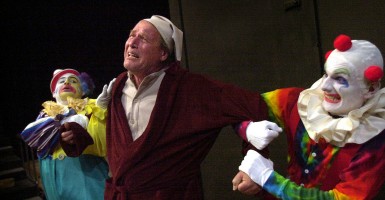New research into humanities education suggests student learning outcomes increase with exposure to the arts.
Few empirical studies have been conducted on the benefits of arts education for students. Jay Greene, endowed chair of the Department of Education at the University of Arkansas, and his team have released two studies on the educational benefits of engagement with the arts.
Last year, Greene, along with researchers Brian Kisida and Daniel Bowen, conducted the first large-scale study of field trips to understand the impact of cultural enrichment through the arts on students’ learning outcomes.
In “The Educational Value of Field Trips,” Greene and his team applied “gold standard” methodology to measure the educational value associated with students who toured an art museum during a field trip. They found that students who attended the tour could recall historical and sociological information about particular works of art at higher rates than students who did not visit the museum.
For example, 88 percent of the students who saw civil-war era painter Eastman Johnson’s work, At the Camp— Spinning Yarns and Whittling, remembered the cultural context of the painting as depicting “abolitionists making maple syrup to undermine the sugar industry, which relied on slave labor.” According to the report, the students’ high rate of recall compared to that of students who did not attend a museum suggests that art could be used to increase the learning capacity of students for traditional classroom content.
They also found students who attended the field trip experienced a large gain in critical-thinking skills, which was observed in their essays regarding particular works of art. Students who attended the museum also showed higher measures of historical empathy, tolerance and a desire to visit more art museums than students who did not tour the museum.
Their findings underscore the value of cultural field trips, which have a long history in American education (although they have been on the decline in recent years, or replaced with non-cultural field trips, such as outings to amusement parks):
Schools gladly endured the expense and disruption of providing field trips because they saw these experiences as central to their educational mission: [S]chools exist not only to provide economically useful skills in numeracy and literacy, but also to produce civilized young men and women who would appreciate the arts and culture. More-advantaged families may take their children to these cultural institutions outside of school hours, but less-advantaged students are less likely to have these experiences if schools do not provide them. With field trips, public schools viewed themselves as the great equalizer in terms of access to our cultural heritage.
Students from rural or high-poverty areas had the largest gains in historical recall of information and critical thinking and reported higher levels of empathy, tolerance and desire to return to the museum.
Greene found similar results in his newest study, “Learning from Live Theater.”
Using the same research design, Greene, with coauthors Collin Hitt, Anne Kraybill and Cari Bogulski, assessed a group of students’ knowledge about theater—and interest in watching or participating in theater—after attending a live performance. The researchers used a sample of students who applied for, and won, tickets to either A Christmas Carol or Hamlet, compared to a control group who lost the lottery.
The study showed students who saw live theater significantly improved their knowledge of the plot and vocabulary related to the play by 63 percent of a standard deviation. The students also showed significantly higher degrees of tolerance and empathy through the “Reading the Mind through the Eyes” test than the control group. The researchers used the RMET measure because it tracks feelings of empathy, and prior research has found that reading literature or engaging in theater enhances one’s ability to read emotions.
Both studies suggest that culturally enriching experiences produce important educational benefits, which in turn could contribute to overall student achievement. Greene’s findings come at a time of concentrated focus on STEM—Science, Technology, Engineering, Mathematics—education.
In 2009, the Obama administration published its “Educate to Innovate” campaign, which included $260 million in partnerships involving the federal government and industry to prepare more than 100,000 new STEM teachers over the next decade But at the 2014 Aspen Ideas Festival, The Atlantic asked thought leaders in academia (Harvard, Yale, and Cal-Berkley) and the private sector, what letter— if any— should be added to STEM education. They all agreed that they would add the letter “A” for the arts and humanities.
“To me, mathematics, computer science and the arts are insanely related,” said Sebastian Thrun, CEO of Udacity and Founder of GoogleX. “They’re all creative expressions.”
“[Arts and humanities] seem to me such an important dimension of educating students about what science, technology, engineering and math are for,” said Harvard President Drew Gilpin.
Greene’s studies and advocates of STEAM both suggest the arts could enhance learning in reading, math and the hard sciences. Student engagement of the arts, through field trips and live performances, also provides positive reinforcement for cultural institutions within communities to contribute to students’ overall education. As the authors concluded, “Schools produce important educational outcomes other than those captured by math and reading test scores, and it is possible for researchers to collect measures of those other outcomes. If what’s measured is what matters, then we need to measure more outcomes to expand the definition of what matters in education.”

























